If you’ve ever used a rice cooker, you may have noticed that it tends to bubble and boil during the cooking process, sometimes even overflowing and making a mess on your countertop. While this can be concerning to some, it’s actually a natural part of the rice cooking process.
Rice cookers work by bringing the water and rice to a boil and then simmering them until the water is absorbed and the rice is cooked. During this process, bubbles will form and rise to the surface, which can cause the water to overflow if there’s too much of it. Knowing why this happens and how to prevent it can help you make perfect rice every time!
Key Takeaways:
- Rice cookers often bubble during the cooking process, which is a natural part of the rice cooking process.
- Understanding the science behind rice cooker bubbling can help you prevent issues like overflowing and undercooked rice.
- Maintaining the proper water level and adjusting cooking settings can help prevent excessive bubbling.
Understanding the Rice Cooking Process
Have you ever wondered how rice cookers work their magic? Understanding the science behind the rice cooking process can help you achieve optimal results and reduce the risk of excessive bubbling or boiling over.
The rice cooking process involves several stages, each of which plays a critical role in producing perfectly cooked rice. First, the rice is washed and soaked, which helps to remove excess starch and ensure even absorption of water.
Once the rice is ready, it is placed in the cooker with the appropriate amount of water. As the cooker heats up, the water is absorbed by the rice, causing the grains to swell and soften. Eventually, the water reaches a boiling point and begins to convert into steam, which then escapes from the cooker through a vent.
As the steam is released, it carries away excess moisture and helps to prevent the rice from becoming too mushy. This process of steaming and venting can cause the rice cooker to bubble or boil over, especially if the water level is incorrect or the heat setting is too high.
The Stages of Rice Cooking
| Stage | Description |
|---|---|
| Washing and Soaking | Rice is rinsed to remove excess starch and soaked to allow for even absorption of water. |
| Initial Cooking | Rice and water are added to the cooker, and the heat causes the water to be absorbed by the rice. |
| Steaming | The water reaches boiling point and converts into steam, which loosens the rice grains and carries away excess moisture. |
| Venting | The steam is released through a vent, preventing the rice from becoming too mushy and reducing the risk of bubbling or boiling over. |
By understanding the rice cooking process, you can adjust your cooking technique to achieve the perfect texture and flavor. Experiment with different rice varieties and cooking times, and don’t be afraid to adjust the water level or heat setting to prevent excessive bubbling or boiling.
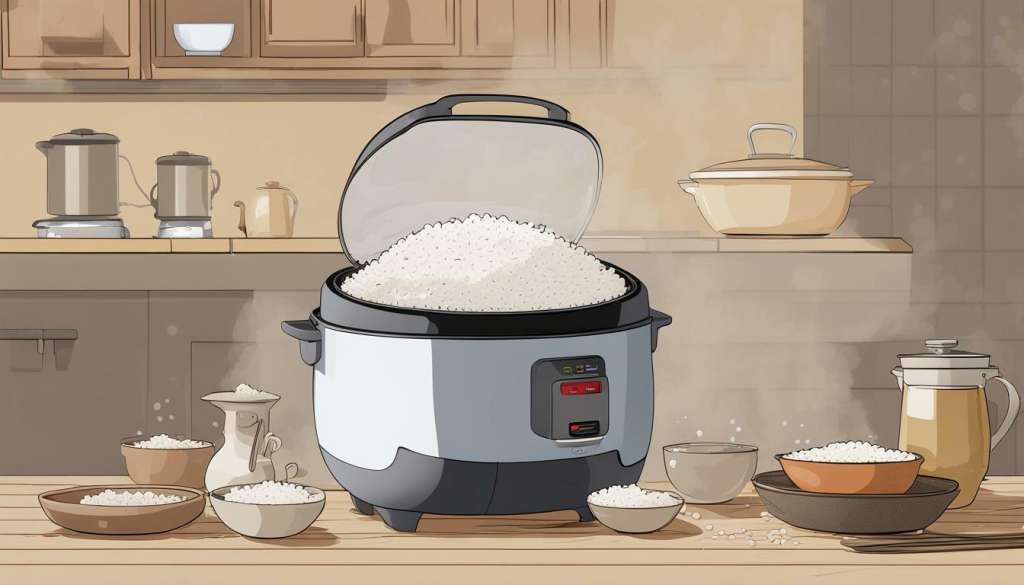
The Importance of Water Level in Rice Cookers
When it comes to using a rice cooker, one of the most critical factors to consider is the water level. Not having the correct amount of water can cause a range of issues, including excessive bubbling. This is why understanding the proper water level for your cooker is essential to achieving perfectly cooked rice.
To determine the ideal water level, you should always refer to the manufacturer’s instructions. The amount of water needed will depend on various factors, such as the type of rice and the cooker’s size. In general, most rice cookers require a 1:1 water to rice ratio, which means using one cup of water for every cup of rice.
However, keep in mind that different rice varieties may need slightly more or less water, and some cookers may require different water levels or ratios. Always check the manual for precise instructions specific to your rice cooker.
| Water Level | Result |
|---|---|
| Too Much Water | Excessive bubbling, boiling over, mushy, or overcooked rice |
| Too Little Water | Dry, uncooked, or crunchy rice |
| Just the Right Amount | Perfectly cooked, fluffy rice with minimal bubbling |
Proper water level is critical to get fluffy rice. Too much water results in mushy or overcooked rice and excessive bubbling. On the other hand, too little water will lead to dry and crunchy rice with little to no bubbling. Only the right amount of water will result in optimal cooking and minimal bubbling.
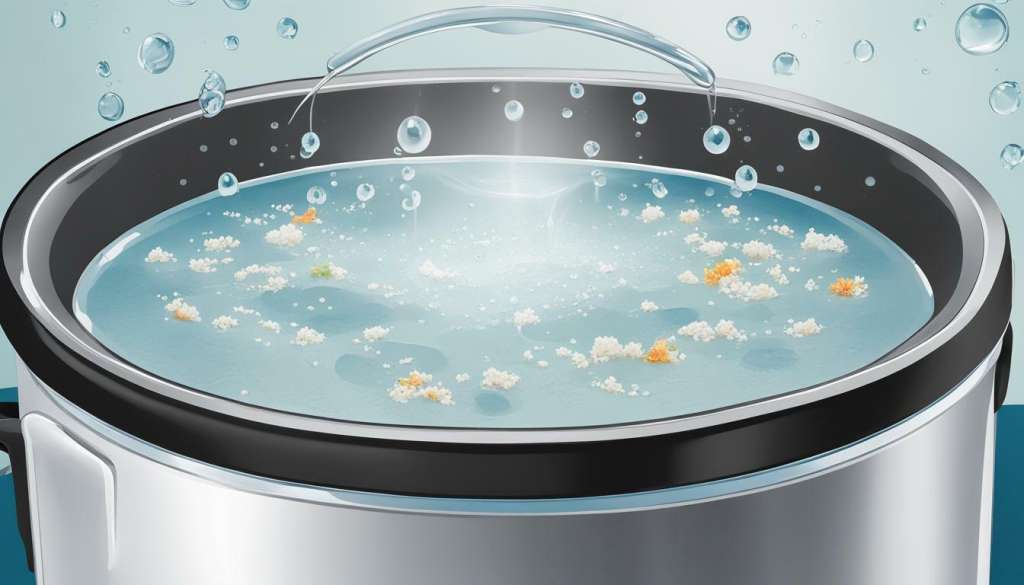
Remember, the water level is not something you can easily eyeball. Always use the measuring cup provided with your rice cooker and use precise measurements to ensure your rice comes out perfectly.
Common Causes of Excessive Bubbling
When using a rice cooker, it’s not uncommon to experience excessive bubbling or boiling over. This can be frustrating, messy, and even dangerous. In this section, we’ll explore some of the common causes of these issues and how to prevent them.
Incorrect Water-to-Rice Ratio
One of the most common causes of excessive bubbling and boiling over is an incorrect water-to-rice ratio. If you use too much water, the excess will boil over, causing a mess. On the other hand, if you use too little water, the rice may not cook properly, leading to burning or sticking to the bottom of the cooker.
Make sure to follow the manufacturer’s instructions regarding the water-to-rice ratio for your specific cooker and variety of rice. Typically, the ratio is about 1:1 for short-grain rice and 1:1.5 for long-grain rice.
Using the Wrong Type of Rice
Another common cause of excessive bubbling is using the wrong type of rice. Different varieties of rice require different amounts of water and cooking times. For instance, brown rice requires more water and generally takes longer to cook than white rice. Using the wrong type of rice can result in either excessive bubbling or undercooked rice.
Refer to the instructions that came with your rice cooker to determine the appropriate water-to-rice ratio and cooking time for the specific type of rice you are using.
Cooking on High Heat Settings
Lastly, cooking on high heat settings can also lead to excessive bubbling or boiling over. This is because the water boils too rapidly, causing foam to form, and ultimately spilling over the top of the cooker.
Instead, opt for lower heat settings as recommended by the manufacturer. This will prevent the water from boiling too rapidly and reduce the likelihood of excessive bubbling.
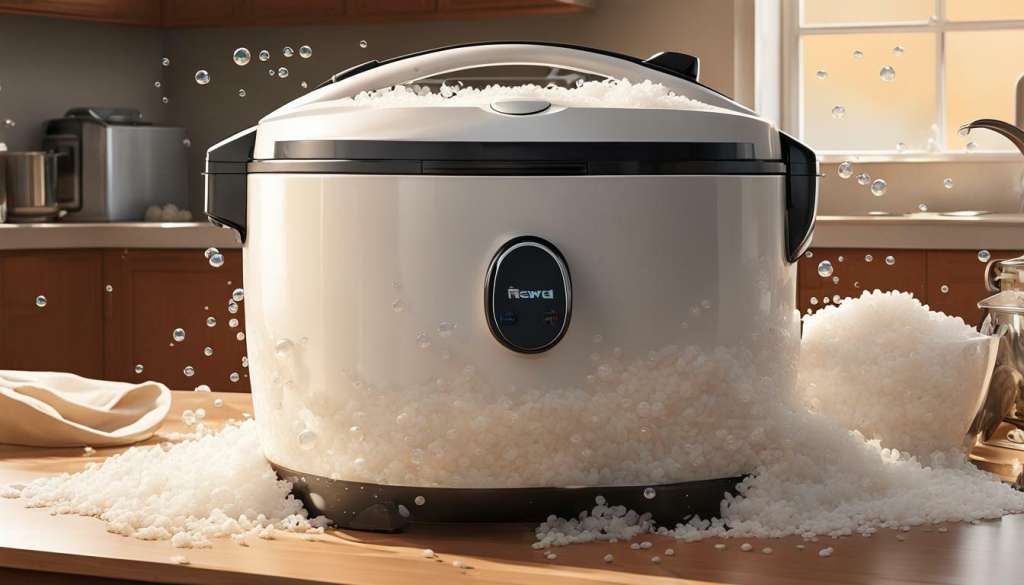
Tip: If your rice cooker is still bubbling excessively, try placing a clean, damp cloth over the top of the cooker to absorb the excess foam.
Tips for Preventing Excessive Bubbling
If you’re experiencing excessive bubbling in your rice cooker, don’t worry. There are several things you can do to troubleshoot the issue and prevent it from happening again in the future. Here are some helpful tips:
Adjust the Water Level
One common cause of excessive bubbling is using too much water. Make sure you’re measuring your water carefully, and adjust the water level as needed based on the type of rice you’re using. As a general rule, you’ll want to use a little less water for shorter-grain rice varieties like sushi rice, and a little more water for longer-grain rice varieties like jasmine rice.
Additionally, if you’re experiencing bubbling over the sides of the cooker, try reducing the water level slightly. This should help minimize the amount of steam that escapes and reduce the risk of bubbling.
Choose the Right Rice Variety
Not all rice varieties are created equal, and some are more prone to excessive bubbling than others. If you’re consistently experiencing issues with bubbling, consider trying a different type of rice. Basmati rice, for example, tends to produce less foam than some other varieties like brown rice or wild rice.
Adjust Your Cooking Settings
If your rice cooker has multiple settings for cooking rice, such as a “quick cook” or “porridge” option, try experimenting with these to see if they affect how much your rice bubbles. In some cases, using a different cooking setting can help reduce bubbling. Similarly, adjusting the temperature or cooking time of your rice cooker may also help reduce the amount of bubbling you experience.
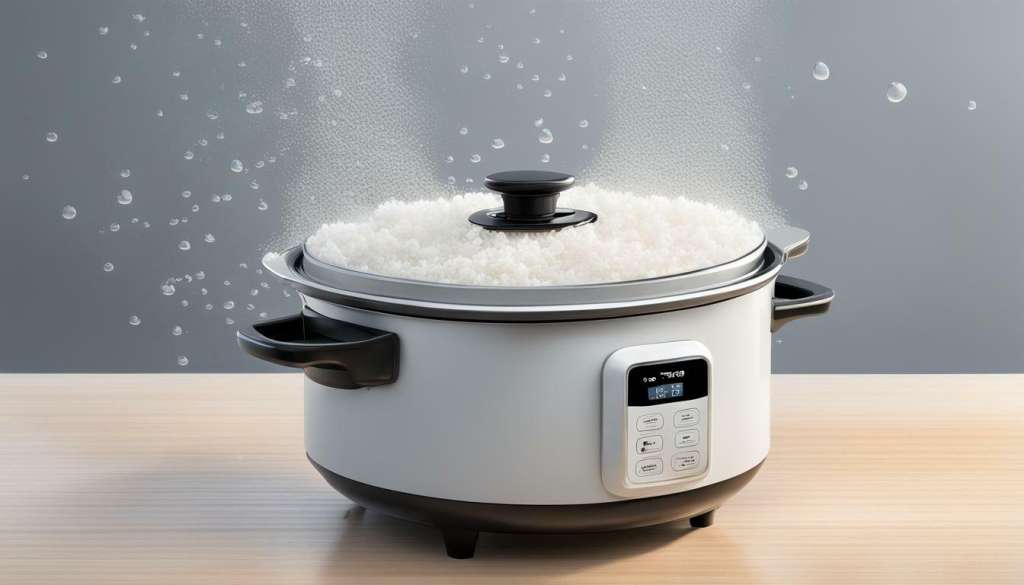
Remember, every rice cooker is a little different, so it may take some trial and error to find the right settings for your particular cooker and rice variety. Don’t be afraid to experiment a little to see what works best for you.
Maintaining Your Rice Cooker
Proper maintenance is essential for ensuring your rice cooker continues to function at its best. Neglecting your rice cooker can lead to issues such as excessive bubbling or even damage to the cooker itself. Here are some simple maintenance tips to keep your rice cooker in top shape:
- Regular cleaning: Clean your rice cooker after each use to prevent grime buildup. Use a soft, damp cloth or sponge to wipe down the inner pot and exterior of the cooker. Avoid using abrasive cleaners that can scratch the surface.
- Check for mineral buildup: Over time, mineral buildup can occur in your rice cooker, particularly if you have hard water. To prevent this, periodically check the heating element and remove any buildup using a soft-bristled brush or toothbrush.
- Replace worn-out parts: If you notice any worn-out parts in your rice cooker such as the inner pot or seal, replace them as soon as possible. This will prevent any damage to the cooker and ensure it continues to function properly.
By following these simple maintenance tips, you can extend the lifespan of your rice cooker and prevent any issues that may lead to excessive bubbling or boiling over.
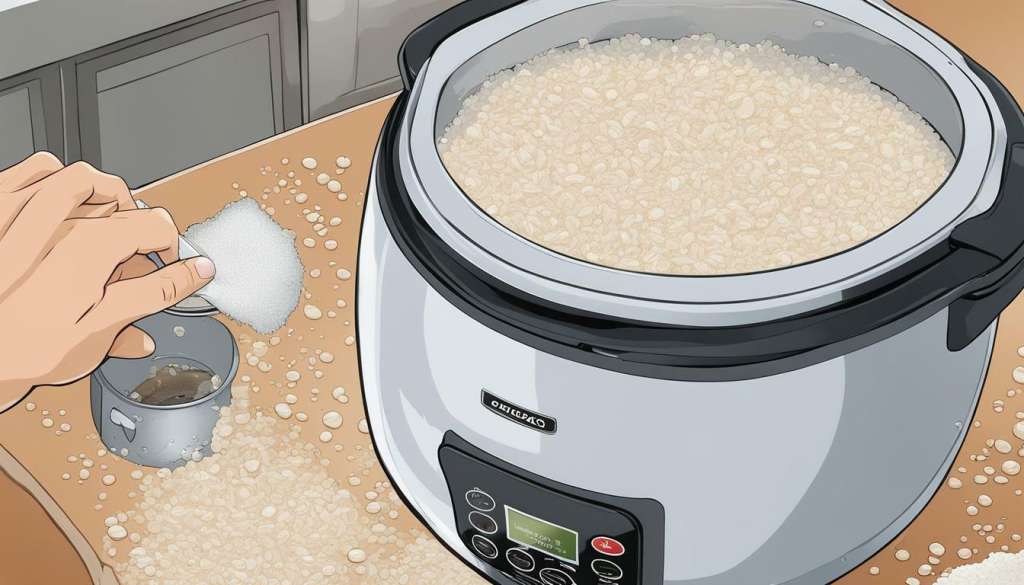
Dealing with Rice Cooker Foam
If you’ve noticed foam forming on the surface of your rice cooker during cooking, don’t panic – this is a common issue that many rice cooker users experience. Foam can lead to excessive bubbling and even cause your rice cooker to boil over, but with a few simple techniques, you can reduce or eliminate it for perfectly cooked rice every time.
First, it’s important to understand why foam occurs in rice cookers. When rice cooks, it releases starch and other natural compounds that can create foam as the rice absorbs water. Additionally, the type of rice you use can also affect the amount of foam that forms. Long-grain and aromatic varieties tend to produce more foam than short-grain rice, for example.
To reduce foam in your rice cooker, try these tips:
- Make sure you’re using the right amount of water for the type of rice you’re cooking. Too much water can cause excess foam, while too little can result in undercooked rice.
- Soak the rice for at least 30 minutes before cooking. This can help remove some of the natural starches that contribute to foam formation.
- Try adding a small amount of oil or butter to the water before cooking. This can help prevent foam from forming and will also add flavor to your rice.
- Reduce the cooking temperature slightly. Cooking on high heat can cause foam to form more quickly, so adjusting the temperature can help reduce foam formation.
By following these tips, you can help prevent foam from forming in your rice cooker and minimize the risk of excessive bubbling or boiling over. Remember, it may take some experimentation to find the right combination of techniques for your specific rice cooker and type of rice, but with a little practice, you’ll be able to cook perfectly fluffy rice every time.
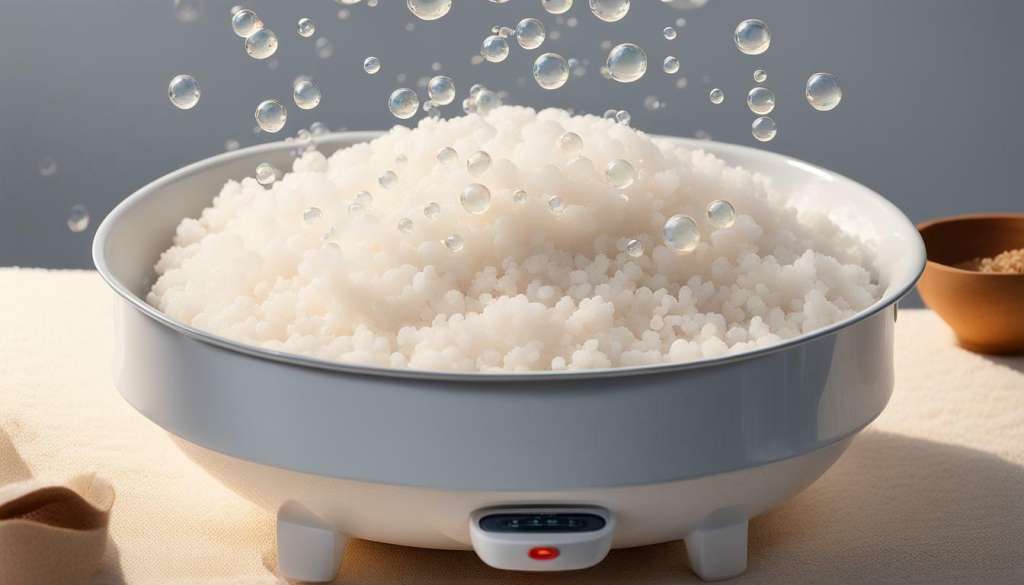
Troubleshooting Common Rice Cooker Issues
Rice cookers are designed to make cooking rice a simple and hassle-free process, but sometimes, things can go wrong. Here are some common issues you may encounter and their possible solutions.
Rice Sticking to the Bottom of the Cooker
If your rice is sticking to the bottom of the cooker, it’s likely because you’re not using enough water. Try using a ratio of 1 1/2 to 1 3/4 cups of water for every cup of rice. Also, avoid using high heat settings. Instead, opt for a low or medium heat setting and allow the rice to cook slowly and evenly. This will prevent the rice from sticking to the bottom of the cooker and ensure that it cooks evenly throughout. Another tip for preventing rice sticking is to give the rice a quick stir halfway through the cooking process, making sure to scrape the bottom and incorporate any stuck grains. By following these tips, you can enjoy perfectly cooked, fluffy rice every time.
Unevenly Cooked Rice
Unevenly cooked rice can be caused by using too much or too little water. Follow the recommended water-to-rice ratio on the packaging or in your user manual. Also, avoid opening the lid during the cooking process, as this can release steam and affect the cooking temperature.
Excessive Bubbling or Boiling Over
If your rice cooker is bubbling or boiling over, it’s likely because you’re using too much water or not using the right type of rice. Adjust the water level based on the recommended ratio for the type of rice you’re using. Also, make sure that the inner pot is properly seated in the cooker and that the lid is firmly closed.
Rice Cooker Not Turning On
If your rice cooker is not turning on, check to make sure that it’s properly plugged in and that the outlet is working. Also, make sure that the inner pot is properly seated in the cooker and that the lid is firmly closed. If none of these solutions work, contact the manufacturer or a professional for assistance.
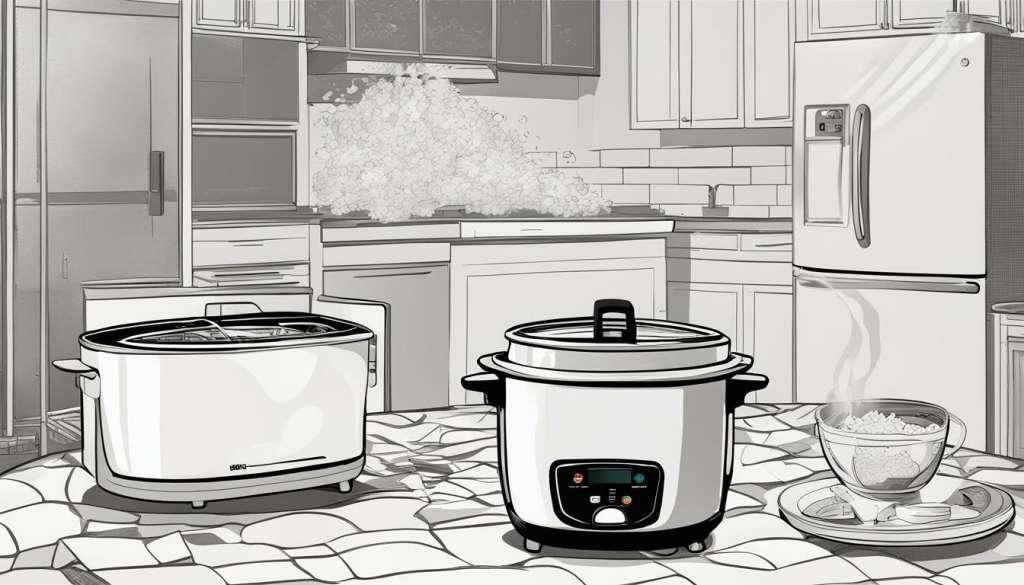
By knowing how to troubleshoot common rice cooker issues, you can ensure that your rice comes out perfectly every time. Remember to follow the recommended water-to-rice ratio, avoid opening the lid during the cooking process, and adjust the heat settings as needed. With a little trial and error, you’ll be able to master the art of rice cooking in no time.
Conclusion
In conclusion, understanding why your rice cooker bubbles is crucial for achieving perfectly cooked rice every time. By comprehending the science behind the cooking process, you can minimize issues such as excessive bubbling and boiling over.
Remember to maintain the correct water level and adjust your cooking settings accordingly to prevent your rice cooker from bubbling over. If you experience issues such as foam or uneven cooking, follow our troubleshooting tips to resolve these problems and perfect your rice cooking technique.
Experiment and Adjust Your Cooking Technique
Don’t be afraid to experiment and adjust your technique to achieve the perfect rice texture and flavor. With proper maintenance and a little bit of practice, you can master your rice cooker and impress your family and friends with perfectly cooked rice every time!
FAQ
Q: Why does my rice cooker bubble?
A: Rice cookers often bubble during the cooking process due to the release of steam and the absorption of water by the rice. This is a normal occurrence and helps to ensure that the rice is properly cooked.
Q: How does the rice cooking process work in a rice cooker?
A: Rice cookers work by heating the rice and water mixture to a boil, which then allows the rice to absorb the water. Once the water is absorbed, the cooker switches to a lower heat setting to finish the cooking process. This absorption and release of steam can lead to bubbling.
Q: What is the importance of maintaining the proper water level in a rice cooker?
A: Maintaining the proper water level is crucial in a rice cooker as too much or too little water can affect the cooking process. Too much water can result in excessive bubbling or the rice cooker boiling over, while too little water can lead to undercooked rice.
Q: What are some common causes of excessive bubbling in rice cookers?
A: Excessive bubbling in rice cookers can be caused by factors such as using the wrong water-to-rice ratio, using the wrong type of rice, and cooking on high heat settings. These factors can contribute to an imbalance in the cooking process and result in excessive bubbling.
Q: What are some tips for preventing excessive bubbling in rice cookers?
A: To prevent excessive bubbling in rice cookers, it is recommended to adjust the water level based on the desired texture of the rice, choose the right rice variety for your recipe, and adjust the cooking settings to a lower heat if necessary. These techniques can help minimize bubbling and ensure optimal cooking results.
Q: How can I maintain my rice cooker?
A: Regular maintenance is important to keep your rice cooker in optimal condition. Simple maintenance tasks include cleaning the cooker regularly, checking for mineral buildup, and replacing any worn-out parts. These steps can help ensure that your rice cooker performs well and minimizes bubbling.
Q: How can I deal with foam in my rice cooker?
A: Foam that forms on the surface of rice during cooking can contribute to excessive bubbling. To reduce or eliminate foam, you can rinse the rice before cooking, use a larger cooker to prevent overflow, or add a small amount of oil to the cooking water. These techniques can help minimize foam and prevent bubbling over.
Q: What are some common rice cooker issues and how can I troubleshoot them?
A: Common rice cooker issues include rice sticking to the bottom of the cooker or uneven cooking. To troubleshoot these issues, you can try using non-stick cooking spray, adjusting the water-to-rice ratio, or stirring the rice halfway through the cooking process. These troubleshooting tips can help resolve these problems and minimize bubbling.
Q: Why is it important to understand the science behind rice cooker bubbling?
A: Understanding the science behind rice cooker bubbling can help you adjust your cooking techniques and achieve optimal results. By knowing the factors that contribute to excessive bubbling, you can prevent issues such as boiling over and ensure properly cooked rice.


